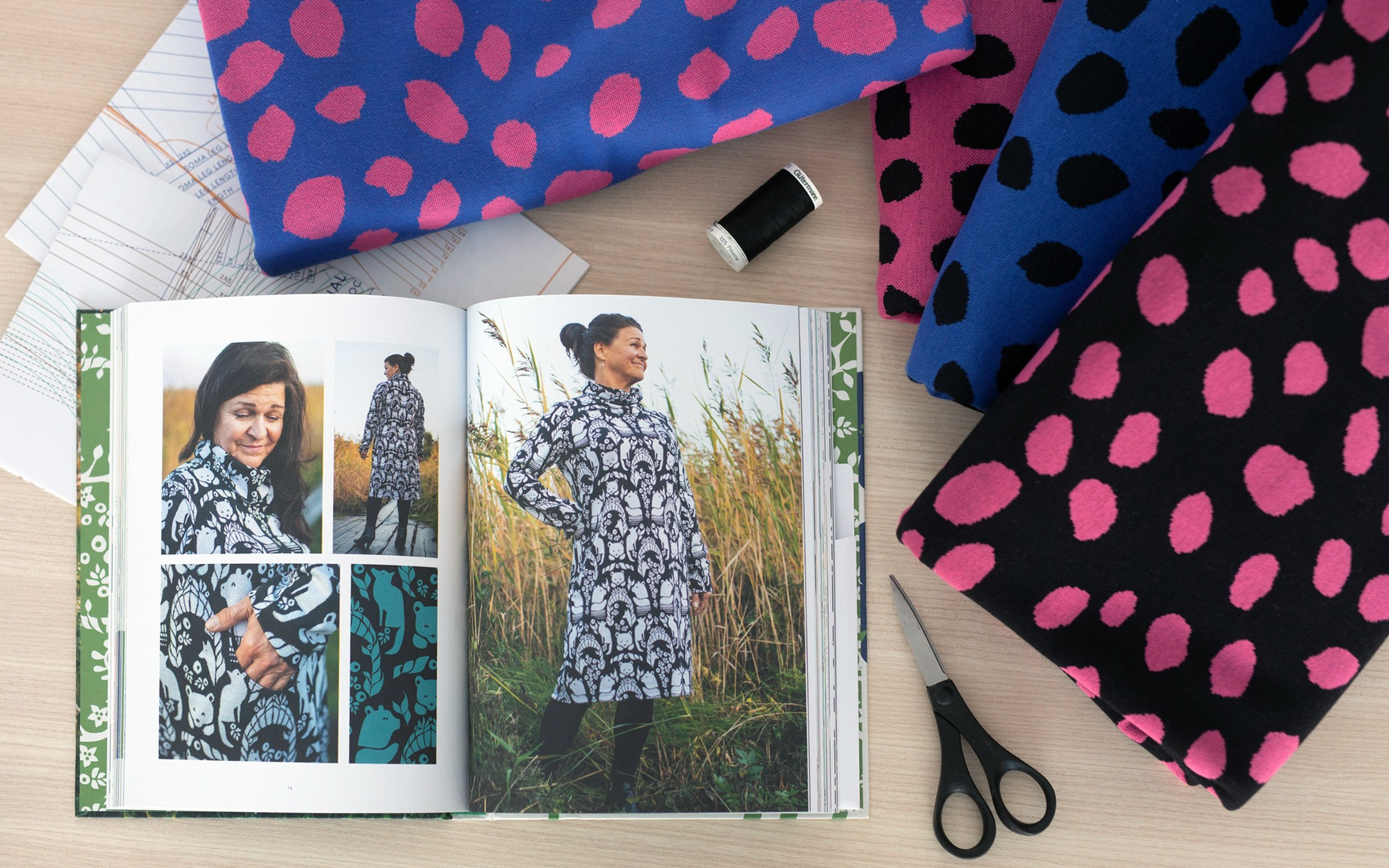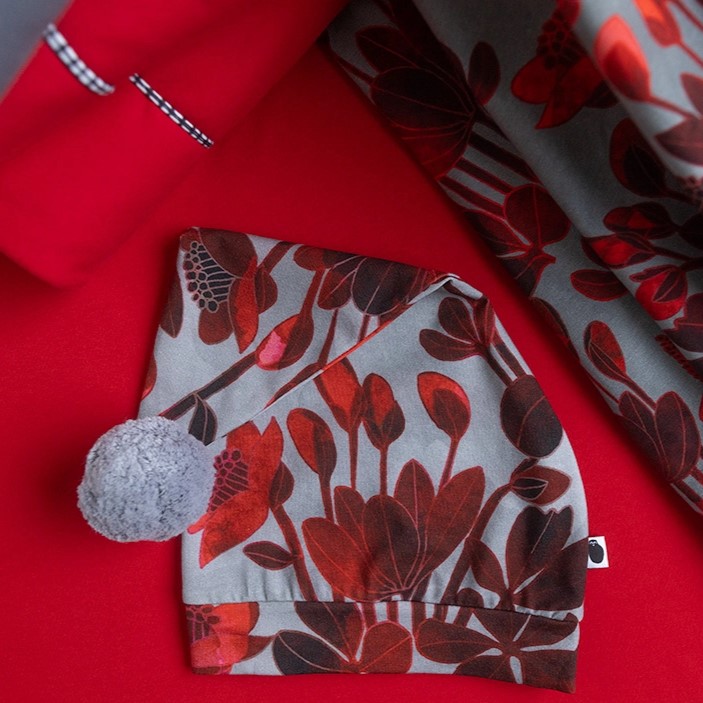Are you planning a sewing project but still wondering how much fabric to order? When estimating fabric requirements, factors such as the size of the garment, the pattern, the width of the fabric, and the cutting layout must be considered—meaning how the patterns are intended to be laid out on the fabric. The pattern creator typically calculates the amount of fabric needed to sew the garment. The instructions specify the intended material and the fabric width the pattern is designed for.
In addition to the pattern and cutting layout, it's essential to consider fabric shrinkage, which can be, for example, 5-10% in natural materials. Fabric shrinkage is usually indicated in the material's product information. Note that the fabric may not shrink equally in length and width. All fabrics should be washed according to the care instructions before sewing. A garment made from pre-washed fabric maintains its shape and doesn't shrink significantly during subsequent washes. When ordering fabric, the material is not automatically cut with an extra allowance for shrinkage, so this must be factored into the calculation of the ordered quantity.

PaaPii has published three pattern books where the instructions include the estimated fabric requirements. If you'd like to sew something from PaaPii's patterns, our customer service can assist you with the correct ordering quantities. This way, you can order the pattern book and necessary fabrics simultaneously if you wish.
How do I estimate the amount of fabric to order if I don't have a pattern ready?
For women's clothing, a good rule of thumb for calculating fabric requirements is the length of the upper part + sleeve length + seam allowance + fabric shrinkage. You can estimate the fabric requirements by measuring the shoulder-to-hem length of a garment in the right size and the sleeve length. Then, make a calculation based on these measurements. When it comes to women's clothing, the garment size and fabric width can significantly impact how much fabric is needed. Fabrics where the pattern can be cut in two directions can reduce fabric requirements, as there are more layout options when creating the cutting plan, and fewer scraps are generated. If the garment has a large collar, a hood, large gussets, or a particularly wide hem, more fabric is often needed than indicated in the basic instructions.
For small children's clothing, a simple way to calculate the size is the length of the upper part + seam allowance + fabric shrinkage. Fabric requirements can be estimated by measuring the shoulder-to-hem length of a garment in the appropriate size and making a calculation based on that.
An example of calculating how much fabric is needed for sewing a jersey shirt for a child:
The desired shoulder-to-hem length of the garment is 43 cm in a 104 cm jersey shirt. The fabric requirement is calculated as follows:
Shoulder-to-hem length 43 cm + seam allowance at the shoulder 1 cm and hem seam allowance 2 cm = 46 cm Shrinkage (5-10%) for a 46 cm long fabric is approximately 4 cm
The measurements sum up to 46 cm + 4 cm = 50 cm.
Based on the calculation, a 104 cm jersey shirt can be sewn from a fabric piece of half a meter. For a tunic, you will need a little more fabric since the shoulder-to-hem length is longer than that of a jersey shirt.
Estimated Fabric Requirements
You can order fabrics using this guide for estimations if you don't have a pattern yet. However, always check the exact fabric requirements and material list in the sewing instructions of the pattern if possible. The fabric estimates are calculated for PaaPii's organic cotton jersey or sweatshirt fabric, which the clothes in PaaPii pattern books are made of.
Baby Clothes
Body:
For sizes 44-62, fabric requirement is 50 cm; sizes larger than this, 60 cm.
Soft pants or leggings with waistband:
For sizes 44-74, fabric requirement is 40 cm; sizes larger than this, 50 cm.
Jumpsuit in jersey:
For sizes 44-62, fabric requirement is 60 cm; sizes larger than this, 70-80 cm.
Children's Clothes
Jersey shirt: sizes 86-140, fabric requirement 50-70 cm.
Tunic: sizes 86-140, fabric requirement 60-80 cm.
Leggings: sizes 86-140, fabric requirement 60-100 cm.
Sweatshirt or jacket: sizes 86-140, fabric requirement 60-100 cm.
Sweatpants: sizes 86-140, fabric requirement 50-90 cm.
Women's Clothes
Tunic (A-line): size L, fabric requirement 150-170 cm; size 3XL, 190 cm.
Jersey shirt: (long-sleeved) size L, fabric requirement 130-140 cm; size 3XL, 150 cm.
Dress (straight, long sleeves): sizes L - 3XL, fabric requirement 200 cm.
Dress (flared hem, short sleeves): size L, fabric requirement 200 cm; size 3XL, 220 cm.
Leggings (from jersey or sweatshirt fabric): size L, fabric requirement 120 cm; size 3XL, 150 cm.
Hoodie (Halla hoodie): size L, fabric requirement 200 cm; size 3XL, 270 cm.
Jacket (straight pattern from sweatshirt knit or jacquard fabric): size L, fabric requirement 180 cm; size 3XL, 190 cm.
Sweatpants: size L, fabric requirement 170 cm; size 3XL, 200 cm.
In addition to organic cotton fabrics, you may need rib knit fabric, merino wool, sewing threads, or other sewing supplies for your sewing project. Consider everything you might need for your sewing project when choosing fabrics so that you can start sewing as soon as you receive the fabrics.
Do you have questions? Our customer service is happy to assist if you need help or advice regarding fabric ordering, materials, or fabric requirements.

